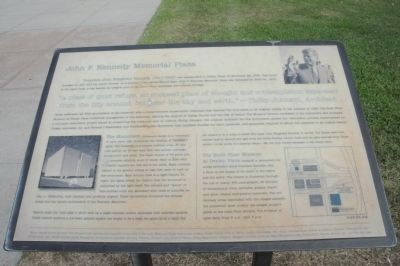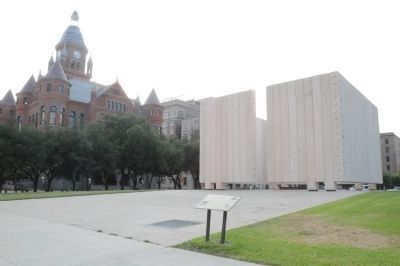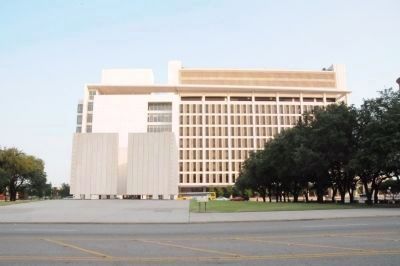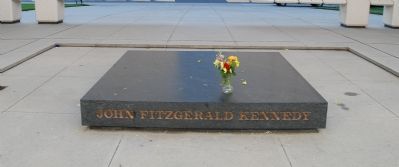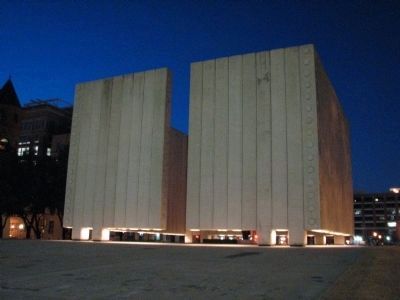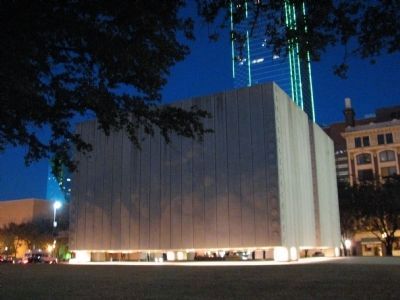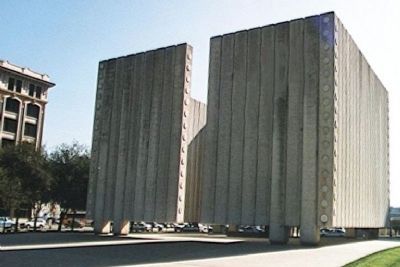Dallas Downtown Historic District in Dallas County, Texas — The American South (West South Central)
John F. Kennedy Memorial Plaza
President John Fitzgerald Kennedy (1917-1963) was assassinated in Dallas, Texas on November 22, 1963. This event changed the city – and the world – forever. As a tribute to this extraordinary man, John F. Kennedy Memorial Plaza was dedicated on June 24, 1970. In the years since, it has become an integral part of the city’s urban landscape and cultural heritage.
“a place of quiet refuge, an enclosed place of thought and contemplation separated from the city around, but near the sky and earth.” – Philip Johnson, Architect
Dallas celebrated the 30th anniversary of the memorial with a comprehensive conservation treatment that restored the monument to its original vitality. In the summer of 1999, The Sixth Floor Museum at Dealey Plaza undertook management of the memorial, rallying the support of Dallas County and the City of Dallas. The Museum became caretaker of the monument and launched a full-scale restoration project aimed at preserving the memorial and its history. Philip Johnson, the original architect for the monument, guided the restoration process implemented by Corgan Associates, Inc. and Phoenix I Restoration and Construction, Ltd. Numerous local suppliers donated the labor, materials, and equipment required to return the memorial to its original beauty.
The Monument. Johnson’s design is a “cenotaph,” or open tomb, that symbolizes the freedom of Kennedy’s spirit. The memorial is a square, roofless room, 30 feet high and 50 by 50 feet wide with two narrow openings facing north and south. The walls consist of 72 white precast concrete columns, most of which seem to float with no visible support two feet above the earth. Eight columns extend to the ground, acting as legs that seem to hold up the monument. Each column ends in a light fixture. At night, the lights create the illusion that the structure is supported by the light itself. The corners and “doors” of this roofless room are decorated with rows of concrete circles, or medallions, each identical and perfectly aligned. These decorations introduce the circular shape into the square architecture of the Kennedy Memorial.
Visitors enter the room after a short walk up a slight concrete incline, embossed with concrete squares. Inside visitors confront a low-hewn granite square, too empty to be a base, too short to be a table, but too square to be a tomb, in which the name John Fitzgerald Kennedy is carved. The letters have been painted gold to capture the light from the white floating column walls and the pale concrete floor. These words – three words of a famous name – are the only verbal messages in the empty room.
The Sixth Floor Museum at Dealey Plaza contains
a permanent historical exhibition about President Kennedy, with a focus on the impact of his death on the nation and the world. The subject is illustrated through the use of nearly 400 photographs, 45 minutes of documentary films, artifacts, graphs, charts, and other related interpretive materials. Two evidentiary areas associated with the alleged assassin are preserved, most notably the alleged sniper’s perch at the sixth floor window. The museum is open daily from 9 a.m. until 6 p.m.
Erected 2000 by The Sixth Floor Museum at Dealey Plaza.
Topics and series. This historical marker is listed in these topic lists: Architecture • Parks & Recreational Areas. In addition, it is included in the Former U.S. Presidents: #35 John F. Kennedy series list. A significant historical date for this entry is June 24, 1970.
Location. This marker has been replaced by another marker nearby. It was located near 32° 46.736′ N, 96° 48.397′ W. Marker was in Dallas, Texas, in Dallas County. It was in the Dallas Downtown Historic District. Marker was on Main Street near S. Record Street, on the right when traveling east. Touch for map. Marker was in this post office area: Dallas TX 75202, United States of America. Touch for directions.
Other nearby markers. At least 8 other markers are within walking distance of this location. A different marker also named John F. Kennedy Memorial Plaza (here, next to this marker);
First Juries to Sit Women in Dallas County (within shouting distance of this marker); The Old Red Courthouse (within shouting distance of this marker); Women's Suffrage in Dallas County (within shouting distance of this marker); Dallas County Records Building (within shouting distance of this marker); Dallas County (about 300 feet away, measured in a direct line); Log Cabin Pioneers of Dallas County (about 300 feet away); Dallas County Criminal Courts Building (about 300 feet away). Touch for a list and map of all markers in Dallas.
More about this marker. On the left side of the marker is a picture of the Memorial provided courtesy of Nathan Shands. In the upper right of the marker is a photograph of President Kennedy taken by John Mazziotta and found in the Dallas Times Herald Collection of The Sixth Floor Museum at Dealey Plaza.
The bottom of marker is text thanking the sponsors who helped make the restoration possible. It reads, "Many thanks to the sponsors who donated their services and supplies to the John F. Kennedy Memorial Plaza restoration project:
Dallas County, City of Dallas, Corgan Associates, Inc., Philip Johnson/Alan Ritchie Architects, Phoeniz I Restoration and Construction, Ltd., United Rentals Aerial Equipment, Architectural Concrete Services, Precora, ProSoCo, Inc., Publicis/Dallas, Hotsy Equipment, Neogard, Division of Jones Blair, MarbleLife, Sika Corporation, Slocum Electric, Inc. and Site Services."
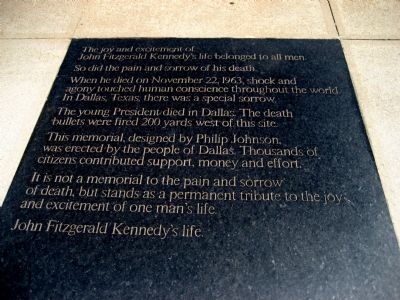
September 20, 2007
9. "John Fitzgerald Kennedy’s life."
A square granite memorial next to this marker reads,
"The joy and excitement of John Fitzgerald Kennedy’s life belonged to all men.
So did the pain and sorrow of his death.
When he died on November 22, 1963, shock and agony touched human conscience throughout the world. In Dallas, Texas, there was a special sorrow.
The young President died in Dallas. The death bullets were fired 200 yards west of this site.
This memorial, designed by Philip Johnson, was erected by the people of Dallas. Thousands of citizens contributed support, money and effort.
It is not a memorial to the pain and sorrow of death, but stands as a permanent tribute to the joy and excitement of one man’s life.
John Fitzgerald Kennedy’s life."
"The joy and excitement of John Fitzgerald Kennedy’s life belonged to all men.
So did the pain and sorrow of his death.
When he died on November 22, 1963, shock and agony touched human conscience throughout the world. In Dallas, Texas, there was a special sorrow.
The young President died in Dallas. The death bullets were fired 200 yards west of this site.
This memorial, designed by Philip Johnson, was erected by the people of Dallas. Thousands of citizens contributed support, money and effort.
It is not a memorial to the pain and sorrow of death, but stands as a permanent tribute to the joy and excitement of one man’s life.
John Fitzgerald Kennedy’s life."
Credits. This page was last revised on April 8, 2024. It was originally submitted on January 11, 2008. This page has been viewed 15,743 times since then and 179 times this year. Photos: 1, 2, 3. submitted on June 10, 2011, by Kevin W. of Stafford, Virginia. 4. submitted on January 11, 2008, by Kevin W. of Stafford, Virginia. 5, 6. submitted on January 16, 2010, by Alan Stricklin of Fort Worth, Texas. 7. submitted on June 10, 2011, by Kevin W. of Stafford, Virginia. 8. submitted on January 10, 2008, by Mike Stroud of Bluffton, South Carolina. 9. submitted on January 11, 2008, by Kevin W. of Stafford, Virginia.
